france
new! Cathedrale Saint-Gatien at Tours 
 updated: Romanesque churches and cathedrals in south-west France updated: Romanesque churches and cathedrals in south-west France
the perpendicular or English style of cathedral 
the fire at the cathedral of Notre-Dame de Paris

cathedral giants - Amiens and Beauvais
Stone tracery in church and
cathedral construction 
stone in church and cathedral construction stained glass and cathedrals in Normandy  
fortified churches, mostly in Les Landes
cathedral labyrinths and mazes in France
using metal in gothic cathedral construction
Germans in France
cathedral destruction during the French revolution, subsidiary page to Germans in France

on first arriving in France - driving
France is not England
paying at the péage (toll station)

Transbordeur bridges in France and the world 2: focus on Portugalete, Chicago,
Rochefort-Martrou
Gustave Eiffel’s first work: the Eiffel passerelle, Bordeaux
a fifth bridge coming to Bordeaux: pont Chaban-Delmas, a new vertical lift bridge
France’s western isles: Ile de Ré
France’s western iles: Ile d’Oleron
Ile de France, Paris: in the context of Abelard and of French cathedrals
short biography of Pierre (Peter) Abelard
Marianne - a French national symbol, with French definitive stamps
la Belle Epoque
Grand Palais, Paris


Pic du Midi - observing stars clearly, A64
Carcassonne, A61: world heritage fortified city
Futuroscope
Vulcania
Space City, Toulouse
the French umbrella & Aurillac
50 years old:
Citroën DS
the Citroën 2CV:
a French motoring icon
the forest as seen by Francois Mauriac, and today
Les Landes, places and playtime
roundabout art of Les Landes
Hermès scarves

bastide towns
mardi gras! carnival in Basque country
country life in France: the poultry fair
what a hair cut! m & french pop/rock

Le Tour de France: cycling tactics 


|
stained glass development
- Earliest from 10th century (900 - 999), but none has survived.
- 12th to 13th century (1100 -1299) - superimposed medallions
intense brilliant blues and red thick glass and leading smoothed down with a plane
Cistercians favoured grisaille windows
- 14th to 15th century (1300 - 1499) - the leading was
no longer handmade, the glass being thinner and so less heavy, thus
enabling larger windows to be made. Gothic canopies were put over human figures.
- 16th century (1500 - 1599) - delicately coloured pictures in thick lead frames, often copied from pictures, with
great attention to detail and perspective
- 17th,18th,19th century (1600 - 1899) - traditional
leaded stained glass often replaced by vitrified enamel or painted glass
- 20th century (1900 - 1999) - the necessity of restoring
or replacing very old stained glass led to both a return
to the original skills and styles, and to modern works,
generally done with greater imagination that the previous
three or four centuries.
wheels
within wheels

West rose window
(exterior) at Orvieto cathedral,
mid-14th century [say 1350]
Circular windows have a tendency to rotate under the
slightest asymmetric pressure. The circle has to be maintained
with spokes of a wheel and arches. The outside of the
circle is, of course, one continuous arch. All these great
buildings, as they developed, were experimental. The centre
of the West Rose at Chartres is still, to this day, off-centre
by about a foot (30 cm), while the transept roses at Notre-Dame
de Paris had to be taken down and redesigned.
There is a war between making the window as solid as
possible and maximising the glass area, a war between
the simple shape and the complexity of the work of art.
Let us make circles within circles, as with the
Chartres glorious west rose. Or how about some squares, as
in the fine example of early plate tracery in Chartres’ north?
Elsewhere can be found triangles and pentagons [Laon
west rose], and perhaps hexagons would be used, or any other shape that
took their fancy - see the seven-pointed star at Rouen.
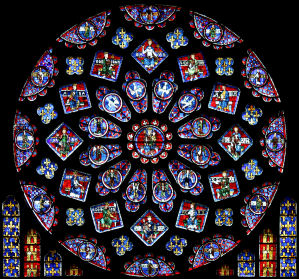
North rose at Chartres cathedral
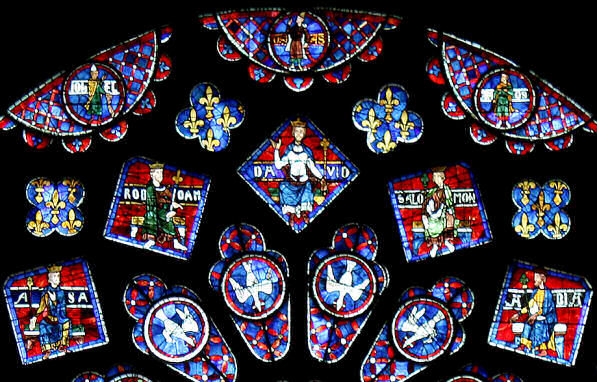
Detail of Chartres north rose, showing squares
with kings of Judea Asa, Rehoboam, David, Solomon, Abijah,
and medallions with prophets Joel, Hosea and Amos.
(For full lists, see box below.)
Chartres north rose
In the outmost ring of this rose, in medallions within a half-circle, are shown twelve prophets, each wearing a pileus or brimless, conical, felt hat. This was a symbol of freedom in ancient Greece and Rome, put on the newly shaven head of a freed slave (traditionally, slaves were required to be bare-headed). The pileus is closely related to the Phrygian cap, well-known as the cap of the french revolutionaries.
"The representations of this Phrygian, or Mysian, cap in sculptured marble show that it was made of a strong and stiff material and of a conical form, though bent forwards and downwards." {Quoted from penelope.uchicago.edu]
I wonder how the pileus became the dunce's hat?
the twelve prophets and the twelve kings of Judea
From 12 o'clock and going clockwise, the twelve prophets are Hosea, Amos, Jonah, Nahum, Zephaniah, Zacharias, Malachi,
Haggai, Habbakuk, Micah, Obadiah, Joel.
The ring of squares shows twelve kings of Judea. Starting from 12 o'clock and going clockwise, they are:
David, Solomon, Abijah,
Jehoshapha, Josiah, Ahaz, Manasseh,
,Hezekiah, Jotham, Jehoram, Asa, Rehoboam. |
Over the next century or two, as the experience of the
builders increased, the tracery became more decorative
and imaginative. The obvious wheels gave way to the more
seemingly organic lines of the flamboyant windows, such
as those at Amiens, Sens and Troyes.
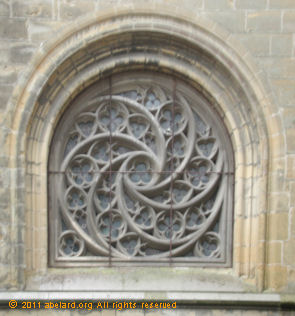 |
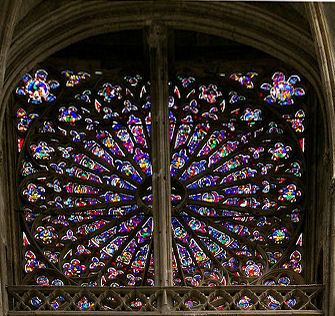 |
| A small spiral window at Bayonne cathedral |
Lozenge, north rose window at Tours cathedral, made in c.1300
The heavy, central, vertical bar (mullion) for reinforcement was added in c. 1371,
as the builders were over-ambitious in their drive for ever more glass. |
These are windows with sweeping spirals and ‘paisley’
shapes. Tours has a lozenge rose; and then there is my very special snowflake window at Sees. Below the rose windows was usually a parade of
lancets, and often a new moon as a tiara filling the space
above.
By the mid-fourteenth
century [say 1350], the flamboyant style was fully developed.
The name flamboyant came from the fiery shapes
of the stone tracery, often also blazing with colour.
In such windows, all straight lines were eliminated, leaving
curving, curling flames. These roses were never to reach
the grand scale of the great gothic roses. The more intricate
stonework of flamboyant rose windows demanded only the
hardest, most consistent stone, which alone could manage
the stresses, even if achieving less ambitious sizes.
In the fifteenth to sixteenth centuries [1400 to 1599],
buildings that had been started centuries earlier were
completed with the latest style of stained glass window
- the flamboyant.
***section on stresses within wheels/spokes**** Tracery always in compression, spokes always in tension. (Note: the word spoke means a different thing in a bicycle wheel to a cartwheel.) Remember, a rose window does turn so the rose is in compression.
rose windows - cathedral window styles
In medieval christianism, paganism was still prevalent;
and there was also an excitement with a mysticism of numbers
that reached right back to Pythagoras. The construction
of the gothic cathedrals and their windows involved very
complex geometries, with on-going challenges to gain stable
structures within the circle.
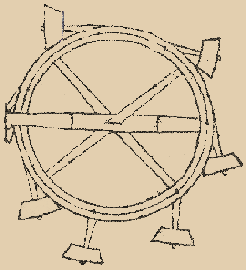 |
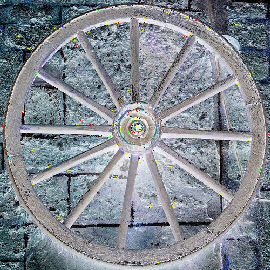 |
Perpetual motion machine,
drawn
by Villard de Honnecourt, c.1225 - 1250 |
A cartwheel
Original image credit: LeoL30 |
Wheels were, of course, technology: wheels for carts
that worked, water wheels, mill wheels, wheels for raising
heavy loads, treadmills for providing power, the spread
of windmills. This was exciting, a new world was developing.
Little detail has come down to us, surviving the intervening
eight hundred years or so. One of the great treasures
that has survived is the design notebook of Villard de
Honnecourt. Who knows, perhaps we can even dream of a
perpetual motion machine powering this revolution? Or
the devil may be confused by a circular maze on the floor,
as can be seen just inside the entrance at Chartres cathedral.
Eight hundred years later, we must gain clues wherever
we may: an illuminated letter in a manuscript, a quick
builder’s sketch on the stones underneath the eaves,
and most of all from examining the buildings.
In a rough chronology:
- Simple oculus: a round hole in the wall
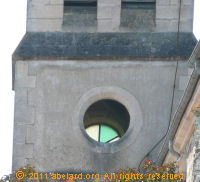 |
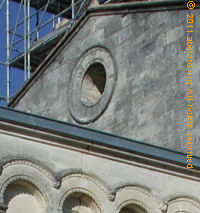 |
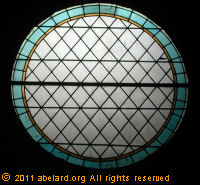 |
| View through
one open oculus to a glass-filled oculus on the other
side of the church belfry. |
Interior
view of same oculus to left, with grisaille glass. |
| Oculus on Romanesque church, with
Roman arches below. |
This what the lighting was like in the old Romanesque
churches. The pictorial assists for the clerics teaching
the illiterate peasants comprised murals of the moral
and uplifting stories.
The Romanesque walls were thick and load-bearing, windows
were weakened sections. Thus the buildings were dim,
illuminated by various forms of lamp. Glass was immensely
expensive, so even an oculus would let in the weather.
Buildings with thick walls do have the advantage of
insulating from the heat and cold.
Come the gothic building revolution and the fundamentals
changed. The realisation grew that between the pillars,
great walls of beautiful glass could turn these public
buildings into magical works of art.
You may read all manner of weighty tomes discussing
the minutiae of gothic architecture, but my impression
is that the walls of glass and uplifting beauty were
the prime drivers of the process. This can even be seen
in the amount of emphasis given by Abbé
Suger to his innovatory work at Saint-Denis in Paris,
and his much lower interest in the
mechanics of the building’s structure.
An example from Laon cathedral

Image
credit: Axe 02
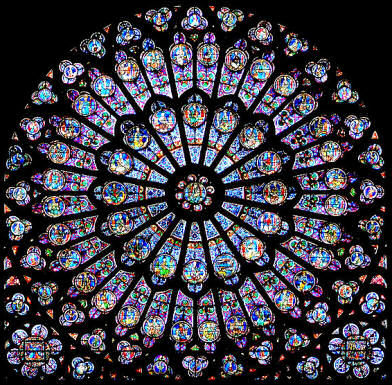
rayonnant rose window, south transept, Notre Dame de Paris
In this next general development, you see patterns mimicking lancet windows. Such windows can be seen in the south rose at Laon, the south rose at Rouen cathedral, (just below), and also the north rose of Ouen Abbey Church in Rouen.

Rouen south rose from the exterior, the glass being grisaille.
Note the highly unusual seven-pointed star at the centre.
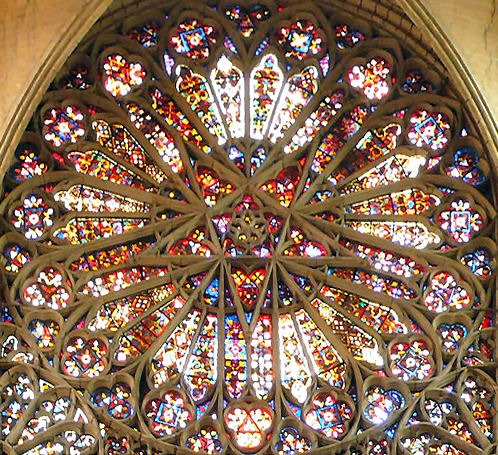
Amiens north transept rose with pentagon and pentagram centre
The north rose at Amiens can be regarded as transitional in design, combining the lancets of the rayonnant and the stone tracery of the flamboyant style.
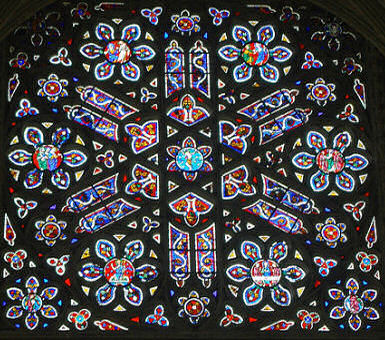
north rose, Sees cathedral
Central medallion: Jesus crucified.
Other medallions, from bottom left and going clockwise:
Jesus risen from the dead; holy women at the tomb; Jesus
appearing to Mary Magdalene; Jesus appearing to Thomas;
Jesus appearing to disciples of Emmaüs; Jesus recognised
by the apostles as he broke bread.
- Flamboyant (flames) - Amiens, Sens, Troyes, Auxerre, Sainte-Chapelle (Paris), Beauvais.
Notice that the tracery is moving steadily away from straight lines and plate tracery to ever more complex curves. The designs moved from rayonnant to flamboyant, that is from rays to flames. Such preferences are common fashions in art, as can be seen in modern times with Art Nouveau and Art Deco.
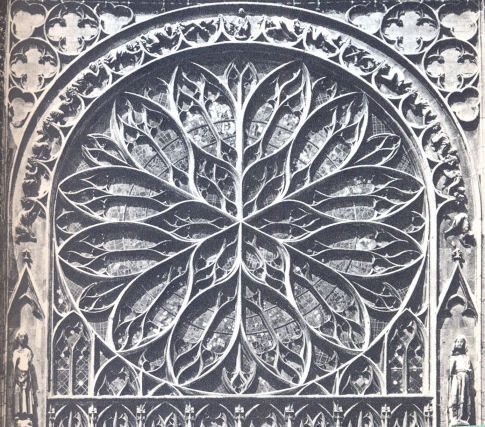
South rose at Amiens cathedral -
external view
As gothic architecture developed, there was less satisfaction
with the great gains in size of window alone. At Amiens, you can see the
much greater complexity of the Flamboyant window. You
can see that the tracery has become far more complex and
even extends outside the are of the rose. That tracery
is called blind tracery, whereas the tracery on the rose
itself is called open tracery. You will also see, around
the edge of the window, one of the best preserved ‘wheels
of fortune’.
![Wheel of fortune at St Etienne's, Beauvais [engraving] Wheel of fortune at St Etienne's, Beauvais [engraving]](/france/culture/rose/beauvais_stetienne_gravure.jpg)
Wheel of fortune at St Etienne's,
Beauvais [engraving]
As the mastery of gothic architecture proceeded, and
great areas opened up to the potential for being glazed,
shapes developed naturally to fill the appropriate spaces.
The circle fitted naturally into the leaping arches, as
did lancets into narrower, pointed openings.
These times were the true renaissance of Northern Europe,
with new techniques, burgeoning populations supported
by the development of deep ploughing on the rich soils
of the North, and growing knowledge.
classifying stained glass windows
Other ways of classifying stained glass windows: 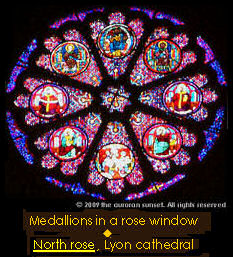
- Medallion windows
In stained glass, a medallion refers variously
to a circular, oval, square, diamond, and a variety of other shaped spaces,
generally one of many within the overall window
design, that contains a figure or figures.
Yoked medallions are two medallions partially joined
together.
- Figure windows like, for example, at Lyon cathedral.
- Story windows (often composed of medallions), such as the Thomas à Becket window at Chartres.
Also see the Saint Julian the Hospitallier window at Rouen cathedral.
- Rose windows - as well as on this page, see, for example, Lausanne rose window.
- Jesse windows (sometimes composed of medallions)
such as the Jesse window at Bourges cathedral.
- Grisaille windows
Grisaille is almost monochrome glass, each piece shaped as a
square or diamond and painted with black enamel
paint. From a distance, grisaille windows have an
overall greyish tint; hence the name grisaille,
meaning greyness in French.

Grisaille window, Poitiers cathedral
- Another way is by shape and tracery, say
- • lancet
pointed, as seen in the arches and windows with
a pointed head introduced in the Gothic period of
architecture. [From the point of a lance - a spear.]
• rose
Or the categories chosen could be - • glass colours and types.
so now for a bit on glass
glass making methods
- At first, in the earlier part twelfth century [1100-1199]
and before, glass was cast and the ingredients added
at significant instants during the melting process.
The result was called ‘pot-metal’.
- As the twelfth century progressed, glass was blown
so to give a much thinner product that was easier to
handle. This‘muff’ glass was blown into
a long cylinder shape. This was then cut open and flattened
into a sheet. Using a red-hot crozing-iron, the sheet
was cut up and the pieces of glass selected for their
position in the final composition.
glass ingredients
- Generally, to make the glass, two parts of beechwood
(or fern) ash were combined with one part of river sand,
the furnace heat fusing the mixture into a slightly
purple-coloured mass (the colour being due to manganese
impurities).
- Metallic compounds were added during fusion to give
the required colour:
- cobalt oxide (from Bohemia) made blue
- copper oxide made red
- silver chloride made yellow
- iron, often a natural contaminant of glass, can
produce yellow, brown or green.
This is why many bottles for beer etc are brown or
green - this is cheaper than purifying the glass.
technique - glass to window
- The design was drawn onto a whitewashed table.
- Pieces of glass were cut and selected so that internal
flaws were well exploited. The f1aws - such as bubbles,
grits of sand, streaks and variations in thickness -
all refract the light as it passes through the glass.
This causes the glass sparkle and sing.
- Some of the glass was shaped and immediately fitted
into the window.
- A much greater proportion received further treatment
with pigment made from a mix of iron filings and resin.
This brought out highlights, shadows, lines and other
details. The pigment was painted on to the glass to
create various details before being fired.
- A technique called flashing was used to make particular
colours and effects.
With flashing, a thin layer of one glass was pasted
onto another differently coloured piece, the ensemble
then being fired to fuse the glasses together.
The main glass receiving this technique was the dark,
ruby red glass. By building up as many as twenty or
thirty thin layers of red glass onto a clear base, fired
after layer added, a rich but not dark red colour was
achieved. This method allowed layers to be ground off
to give varying tones within the glass. Further colours
could be made by staining, rarely done in medieval times.
from
medieval glass to dalle de verre, or slab glass
In medieval times, the manufacture of stained glass
was an esoteric craft involving glass-blowing. The quality
of the glass varied greatly, in consistency, thickness
and so on. The surface varied, bubbles of air were trapped
in the glass, the colour varied, and since those days,
acids in the air and rain, and from pollution, pitted
the outside surfaces over the centuries. This can be
seen in the whitening of the surfaces.
You may think that all this variation is a problem,
but far from it. These variations are a good part of
what gives old windows such character, sparkle and glow.
In fact, restorations over the past century have often
done more harm then good, as some of the life has been
removed from the windows. However, as knowledge grows,
restorers are now often doing a better job.
Eventually, the old handcrafts involved in glass manufacture
were replaced by metal moulding and glass flotation.
The product became consistent, most of the bubbles were
removed, the surface became smooth and the colour evenly
distributed. This ended up in a product lifeless from
the point of view of the finished window. This product
became known, in a monumental misnomer, as ‘cathedral
glass’!
So the glass makers have had to learn all over again
how to produce a more appropriate material and result.
As modern science catches up with medieval craftsmen,
the palette of the stained glass artists is now becoming
good enough even to incite the envy of a 12th century
monk.
Added to the range of glass available, there is now
a great modern innovation dalle de verre, or
slab glass. This material has opened up the possibility
of embedding the inch-thick glass in concrete or resin.
As glass expands at approximately the same rate as the
concrete, these windows can be made to be structural,
as well as damned impressive.
To add still further to the lively colour and light
transmission qualities of this glass, the craftsman
deliberately chips the inside surface of the glass,
with a hammer, as can be seen in the photo just below.
great contemporary stained glass artists
For extended details, go to modern stained glass.
Unfortunately, great stained glass artists are few and
far between. The best I know is Gabriel Loire, who has
unfortunately died recently at a great age. The best example
of his work in England is at St Mary’s College Chapel,
Strawberry Hill, near Twickenham, using dalle de verre.
His son Jacques, and I believe his grandchildren, are
now involved in the business, which has a shop next door
to Chartres cathedral. However, his descendants are not
yet in the same class as Gabriel.
There is a prime example, in a single window, of Chagall’s
work at Chichester cathedral. He has also glazed a complete
church of 12 windows at Tudeley, Kent. But his definitive tour de force is at the 12 magnificent windows
at the chapel of the Hadassa Hospital, a little way out
of Jerusalem. There are also several windows in Metz cathedral,
but these I have not seen.
Matisse has created an impressive chapel at Vence in
Provence, designing practically everything within it,
including the stained glass windows. (Its visiting hours
are limited, so check carefully before visiting.)
See below for a very useful catalogue of stained glass in Britain.
recommended books
 |
The rose window,
splendour and symbol by Painton Cowen
Thames and Hudson [UK], hbk, 2005
276 pages, 350 illustrations, 300 in colour
ISBN-10: 0500511748
ISBN-13: 978-0500511749
£29.99 [amazon.co.uk]
$63.75 [amazon.com]
Previously, Painton Cowen also wrote
Rose windows (Art & Imagination)
pbk, 1990
ISBN-10: 0500810214
ISBN-13: 978-0500810217
amazon.com / amazon.co.uk
Extremely well illustrated - the paperback version has
59 in colour and 82 black-and-white. Densely
packed with facts. An ideal primer to be carried around
with you on any visit. Like so many books, written by
informed hands, it is very badly organised and laid out.
My Thames and Hudson glued 1990 paper-cover version started
falling apart from early on, but always travels in its
own protective plastic cover to keep the pages in one
place. The newer 2005 hardback version has 300 colour and 50 b/w illustrations. It is a real doorstop of a coffee table book.
I can not resist giving these books five GoldenYaks,
if only because I know of nothing better. |

|
|
| Painton Cowen has also produced a very useful directory
of stained glass in Britain - |
 |
A guide to stained glass in
Britain by Painton Cowen, # Michael Joseph
Ltd (June 10, 1985)
ISBN-10: 0718125673
ISBN-13: 978-0718125677
amazon.com / amazon.co.uk |
|
 |
Experiments in gothic
structure by Robert Mark
MIT Press 
pbk 0262630958
reprint: 1984 amazon.com / amazon.co.uk
If you want to understand the structure of the great
gothic cathedrals, this is the place to go. Some of it
gets a bit technical, Mark used polarised light, epoxy
plastic models and wind tunnels to work out the the loadings
and stresses in some of the great cathedrals. An absolutely
fascinating book to read, if you can stand the hard work
and the usual technical manual disorganisation.
As with Painton, I can not resist giving this book five
GoldenYaks, if only because I know of nothing better. |
end notes
- A good start on architecture can
be found in the introduction to the Michelin Green Guide
series.
- Naturally, the greater the magnification
of your binoculars, the greater the problem with handshake.
The greater the magnification, also the more bulk and
weight to carry around. Choosing a pair of binoculars
to suit you is, therefore, a compromise. The small cheap
ones can vary a great deal in quality - try them out
before buying.
- Halation
Light spilling from one section of glass to another.
However, these old craftsmen knew their trade, thus
thickening the leading where this is most likely
to occur. They even could take foreshortening into
account.
- Reims, like everything on the German
side of the World War One German front, lost a great
deal of its treasure, including glass, to German shelling.
The Germans used the cathedrals and churches in the
area for target practice. Hence, all the great stained-glass
treasures of France are to the west of that line.
The philistines of the French Revolution also did a
great deal of damage to French heritage (as mentioned
regarding Saint Denis above), as Cromwell did in England.
The third era of destruction across northern France
was occasioned in driving the National Socialists out
of France in 1944 in association with the D-Day landings.
- Being more precise, and
quoting from Mark [primarily form
p.115], “The Bourges sexpartite vault is estimated
to weigh 370,000 kg (820,000 lb), that is approximately
400 imperial tons. Whereas, Mark estimates that the
Cologne quadripartites to weigh 270,000 kg (600,000
lb), that is going on 300 imperial tons. [An imperial
ton is 2440 lb, while a short or American ton is 2000lb.]
The vaults also have rubble, or fill, to increase pressure
and to help stablise them. This included in the weights
quoted. Mark estimates that the horizontal outward thrust
on the main piers as 28,100 kg (62,000 lb) at Bourges,
and 31,300 kg (69,000 lb) at Cologne. The secondary,
lighter pier at Bourges, Mark estimates at 11,300 kg
(25,000 lb). This gives some comparison of the gains
attained by the Bourges sexpartite vault construction.
- St Etienne’s
is about 1.25 km south of Beauvais cathedral, if you’re
a crow. Unfortunately, this church is now in a very
sad state of repair. In Beauvais, most of the churches
are named for Saint Etienne!

|















